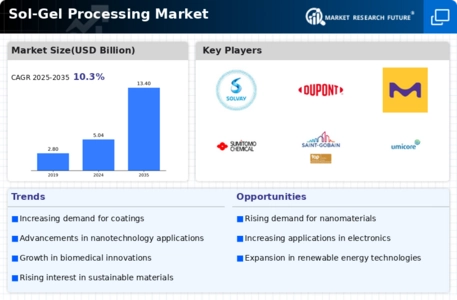Expanding Applications in Healthcare
The Sol-Gel Processing Market is increasingly finding applications in the healthcare sector, particularly in the development of biocompatible materials and drug delivery systems. The unique properties of sol-gel derived materials, such as their ability to form porous structures, make them ideal for use in medical implants and tissue engineering. The healthcare market is projected to grow significantly, with estimates indicating a CAGR of around 9% for sol-gel based applications. This growth is driven by the rising demand for innovative medical solutions and the need for materials that can enhance patient outcomes. As the healthcare industry continues to evolve, the Sol-Gel Processing Market is likely to play a pivotal role in advancing medical technologies.
Rising Demand for Advanced Materials
The Sol-Gel Processing Market is experiencing a notable increase in demand for advanced materials, particularly in sectors such as electronics, optics, and coatings. This method allows for the production of materials with unique properties, including high purity and homogeneity. The market for advanced materials is projected to grow significantly, with estimates suggesting a compound annual growth rate (CAGR) of around 8% over the next few years. This growth is driven by the need for innovative solutions in various applications, including nanotechnology and biomaterials, where sol-gel derived products are increasingly utilized. As industries seek to enhance performance and sustainability, the Sol-Gel Processing Market is well-positioned to meet these evolving needs.
Increased Focus on Sustainable Manufacturing
Sustainability has become a pivotal concern across industries, influencing the Sol-Gel Processing Market. The sol-gel technique is inherently more environmentally friendly compared to traditional methods, as it often requires lower energy consumption and generates less waste. This aligns with the growing regulatory pressures and consumer preferences for sustainable products. The market is witnessing a shift towards eco-friendly materials, with sol-gel processes being adopted for applications in coatings and construction materials that minimize environmental impact. As companies strive to meet sustainability goals, the Sol-Gel Processing Market is likely to benefit from this trend, potentially leading to a market expansion of approximately 6% annually.
Growing Investment in Research and Development
Investment in research and development (R&D) is a key driver for the Sol-Gel Processing Market. As industries seek to innovate and improve product performance, R&D initiatives are increasingly focused on exploring new applications and enhancing existing sol-gel technologies. This trend is supported by both public and private funding, which aims to foster advancements in material science. The emphasis on R&D is expected to lead to breakthroughs in sol-gel applications, particularly in sectors such as energy storage and environmental remediation. With a projected increase in R&D spending in relevant fields, the Sol-Gel Processing Market is poised for growth, potentially expanding its market presence by 5% over the next few years.
Technological Innovations in Sol-Gel Techniques
Technological advancements are playing a crucial role in the evolution of the Sol-Gel Processing Market. Innovations such as the development of new precursors and improved processing techniques are enhancing the efficiency and versatility of sol-gel methods. These advancements enable the production of materials with tailored properties, which are essential for high-performance applications in fields like electronics and photonics. The integration of automation and digital technologies is also streamlining production processes, reducing costs, and improving product quality. As these technologies continue to evolve, the Sol-Gel Processing Market is expected to witness a surge in adoption, potentially increasing market share by 7% in the coming years.


















Leave a Comment